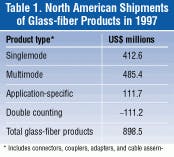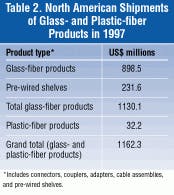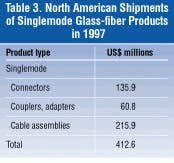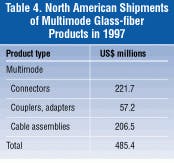Fiber-optic interconnect sales exceed $1.1 billion in 1997
Fiber-optic interconnect sales exceed $1.1 billion in 1997
The same factors that have driven the expansion of fiber-optic technology in North America have benefited the sales of interconnect products.
KEN FLECK, Fleck Research
A tremendous increase in traffic in the core telephone network, data local area networks (lans), and cable TV has accelerated demand for broadband services and video applications in networks around the world. The Internet alone has increased traffic to enormous levels. In North America, long-distance telephone companies project a sevenfold increase in demand for network capacity; the local telephone companies project a fourfold increase in their networks.
Fiber-optic networks offer obvious advantages for dealing with the accelerated demand for bandwidth. They run at the speed and frequency of light, a rate of 2 billion cycles per second. The bandwidth of one strand of fiber is some 25,000 GHz--enough to carry all of the traffic on the telephone network during the peak hour of Mother`s Day in the United States or, as another analogy, all of the radio frequencies currently used in the air for radio, television, microwave, and satellite communications.
Shipments within North America for fiber-optic connectors, couplers, adapters, and cable assemblies reflect the fact that companies are increasingly turning to fiber to meet their high-bandwidth needs. Such shipments reached $898 million in 1997. Pre-connectorized connectors and cable assemblies (pre-wired shelves) added another $232 million. The total for all glass fiber interconnects was $1.13 billion. Plastic-fiber connectors accounted for another $32 million. Excluded from these shipment figures are transceivers, isolators, attenuators, collimators, amplifiers, and controllers. Shipments for the total North American fiber-optic connector, coupler, adapter and cable assembly industry were up 12.1% in 1997, compared to 1996.
Driving forces and key events
Fiber-optic interconnects come in a large number of designs, which can be divided into three categories:
Singlemode: In connectors, designs in-
clude fc/pc, SC, ST, biconic, D4, quick-connect, fc-apc, sc-apc, din-apc, LC, E-2000, and D3. Couplers and adapters include ST, SC, fc/pc, biconic, and E-2000. Cable assemblies feature such commercial designs as SC, FC, ST, D4, biconic, sc-apc, fc-apc, and E-2000 as well as application-specific and military designs.
Multimode: Connector approaches in-
clude such single-fiber designs as the ST, SC simplex, sma, fc/pc, quick-connect, biconic, military, mini-bnc, and E-2000. Duplex and multifiber connector designs include Fiber Distributed Data Interface (fddi), Escon, MT, mini-MT, MU, mpo, mpx, backplane, mac, mt-rj, scdc/scqc, opti-jack, LC, and VF-45. Multimode coupler and adapter schemes include the ST, SC, Escon, biconic, and E-2000. Multimode cable assemblies come in such commercial designs as the ST, SC, FC, sma, biconic, and E-2000. Meanwhile, duplex and multifiber cable designs are represented by the duplex SC, Escon, fddi, MT, mini-MT, mpo, mt-rj, VF-45, application-specific, military, fan-out, and multiple fiber.
Application-specific connectors: This
connector type includes angle-polished, polarization-maintaining, expanded-beam, underwater, hybrid and multifiber, military termini, fusion splices, and mechanical splices.
The use of these connectors has been affected by several changes in the way fiber optics has been applied. Formerly, fiber-optic applications were dominated by long-line networks such as interexchange, interoffice, submarine, and cable-TV trunk. Today, demand is accelerating in data-intensive lans. Many technological advancements occurred during the past year to accelerate the evolution away from strictly backbone applications. A few of these included subscriber broadband distribution architectures; fiber-to-the-curb networks for delivery of voice, video, and data services to optical network units located in residential neighborhoods; hybrid fiber/coaxial cable for cable-TV; and fast lan technologies such as Asynchronous Transfer Mode (atm) and fddi. Additionally, advancements continued in wavelength-division multiplexing. As this technology grows to involve transmission of wavelengths spaced in ever-closer proximity, the technique has come to be frequently called dense wavelength-division multiplexing.
These advances have spurred fiber-optics manufacturers to put more resources into opening new markets. For example, numerous competing fiber-optic network designs closed the gap between fiber and the Category 3 and Category 5 copper systems that currently dominate horizontal premises networks. The objective is to push fiber all the way to the desktop with connectors that provide the cost-effectiveness of copper modular jacks. Five competing designs vied for the attention of the Telecommunications Industry Association`s Commercial Building Cabling Standards Working Group (TR-41.8.1) looking to adapt an updated fiber-optic connector standard (see Lightwave, May 1998, page 44). The five competing designs were the mt-rj developed by amp, Siecor, Hewlett-Packard, usconec, and Fujikura; the Volition VF-45 from 3M; the Optispeed LC from Lucent Technologies; the scdc/scqc from Siecor, Siemens, and ibm; and the opti-jack from Panduit. The VF-45, meanwhile, received approval from the Fibre Channel Association.
These duplex and multifiber connectors will experience the highest growth rate in the fiber-optic interconnect industry. The projected growth for this category--which includes such designs as the SC duplex, fddi, Escon, MT, mpo, mac, mini-MT, backplane connectors, MU mother/ daughtercard connectors, LC, opti-jack, mt-rj, scdc/scqc, and VF-45--is a very high 25.9% per year compound annual growth rate (cagr) to the year 2002.
On other fronts, there were continued and expanded design activities carried out on modules that can accommodate up to 12 fibers, such as mpo. Coming next is the smaller, MT-ferrule-based mpx, which also accommodates up to 12 singlemode or multimode fibers, has SC-style latching, and is designed to meet Bellcore 1435 specifications.
Next-generation computer processors will have clock rates approaching 600 MHz, and even 1-GHz processors are on the drawing board. These clock rates will necessitate tens of gigabytes per second interconnections within computer systems. Research went forward on parallel optical interconnects led by the Parallel-Optical Link Organization (polo), an industrial consortium headed by Hewlett-Packard. Prototypes were completed for first- and second-generation designs (polo-1 and polo-2) of a vertical-cavity surface-emitting laser (vcsel) based optical interconnect device. These are 10-channel modules based on 980- and 850-nm vcsels, respectively (data- transmission rates are 6 and 10 Gbits/sec). amp was a developer of the connectors (which are latched, push-pull, multichannel, and MT-ferrule-based) as well as a receptacle housing for the polo design.
Industry attention also continued on quick-connect fiber-optic connectors that eliminate epoxies and polishing. These include such connectors as CrimpLok (3M), LightCrimp (amp), CamLite and UniCam (Siecor), and OptiMax (nordx/cdt).
Finally, plastic optical fiber continued to gain popularity for short-distance communication links between computer and consumer electronic devices.
Industry shipments
As shown in Table 1, the total North American shipments of glass-fiber connectors, couplers, adapters, and cable assemblies was $898.5 million. This total is subdivided among singlemode, multimode, and application-specific designs. Over the next five years, the projected growth to the year 2002 for singlemode is 4.4% cagr; multimode is 9.5% cagr; and application-specific is 10.7% cagr. When plastic-fiber connectors are included, the total North American shipments in 1997 increased to $930.7 million. Over the next five years, the projected growth to the year 2002 for glass- and plastic-fiber connectors, couplers, adapters, and cable assemblies is 9.1% cagr.
When pre-connectorized connectors and cable assemblies (pre-wired shelves) are added to glass- and plastic-fiber connectors, couplers, adapters, and cable assemblies, North American shipments in 1997 increased to $1.162 billion (see Table 2). Over the next five years, the projected growth to the year 2002 for pre-wired shelves is 11.1% cagr.
A closer look at how these figures for 1997 came about is instructive. Singlemode connectors; couplers and adapters; and cable assemblies are subdivided in Table 3, while multimode connectors; couplers and adapters; and cable assemblies are subdivided in Table 4. Table 5 subdivides multimode glass-fiber connectors into two subdivisions: single-fiber connectors versus duplex and multifiber connectors. Over the next five years, duplex and multifiber connectors will achieve the highest growth--a projected cagr of 25.9%. This compares to a cagr of 4.4% for the single-fiber connectors.
New and expanded offerings
During the past year many suppliers expanded their product offerings. These products included the aforementioned mt-rj from amp and Siecor, backed by the other members of the mt-rj consortium. Meanwhile, 3M`s Volition VF-45 uses no ferrule and is reported to offer significant cost savings. Additionally there were the LC (Lucent), scdc/scqc (Siecor, Siemens, and ibm), and opti-jack (Panduit) connectors. Packard Hughes Interconnect introduced the High-Speed Plastic Network connector. Thomas & Betts introduced a new technology for small bends in optical fibers and single-sided splitters. There were expanded product offerings in MT, mini-MT, and MU formats. The mpo ramped up to significant volume--and mpx will ramp up in 1998.
However, price erosion remained a significant factor in 1997, ranging between 10% and 15%. This follows price erosion in prior years of up to 30%. Some manufacturers reported ST multimode connectors with ceramic ferrules priced as low as $1.25; however, most of the selling is in the $1.70 to $1.80 range.
Some manufacturers reported SC multimode connectors priced as low as $1.75 to $1.80. To be competitive in multimode connectors, a manufacturer currently has to price these products under $2.00. It was not too many years ago when the price was $3.00. Going back a few years further, the price was $10. Leading to lower prices has been the introduction of plastic and aluminum ferrules. A manufacturer can hold a higher price line when selling to the network industry, or if the company holds a high market share in a particular product line.
Market size by product type
There are 88 design types of fiber-optic connectors, couplers, adapters, and cable assemblies. In singlemode connectors, the top three product lines are the SC, FC, and ST, followed by the biconic and D4. These five designs accounted for 89% of all singlemode connector shipments in North America in 1997. Over the next five-year period, the highest growth is projected to occur in quick-connect designs and the SC. In singlemode couplers and adapters, the top three product lines are the ST, SC, and FC. These three accounted for 84% of all singlemode coupler and adapter shipments in North America in 1997. In singlemode cable assemblies, the top three product lines are the SC, FC, and ST, followed by D4. These four accounted for 85% of all singlemode cable assembly shipments in North America for the year 1997.
In multimode connectors, the top eight product lines are the ST, SC simplex, fddi, sma, quick-connect, Escon, FC, and SC duplex. These eight designs accounted for 75% of all multimode connector shipments in North America for 1997. The highest growth over the next five-year period is projected to occur in the mt-rj, VF-45, MU, SC duplex, mini-MT, MT, mpo, mpx, quick-connect, and SC simplex designs.
In multimode couplers and adapters, the top two product lines are the ST and SC. These two designs accounted for 73% of all multimode coupler and adapter shipments in North America for 1997. In multimode cable assemblies, the top five product lines are the ST, SC, Escon, fddi, and FC. These five designs accounted for 73% of all 1997 multimode cable assembly shipments in North America.
The industry leaders
Fleck Research has identified 130 suppliers of fiber-optic connectors, couplers, adapters, cable assemblies, and pre-wired shelves. As fiber-optic suppliers from Taiwan and the People`s Republic of China have begun to capture minute market shares in North America, it is most likely that there are an additional dozen or more other suppliers who have yet to be identified.
The total North American fiber-optic connector, coupler, adapter, and cable assembly market increased 12.1% in 1997, compared to 1996. Suppliers typically recorded increases in the 10% to 15% range, although a few suppliers enjoyed increases of 30% to 35%. There were suppliers, however, that recorded low single-digit growth and even negative growth in the year 1997. In most cases, this was due to price erosion.
The top 10 industry leaders for glass-fiber connectors, couplers, adapters, and cable assemblies, in descending dollar sequence of 1997 shipments, were Lucent, amp, 3M, adc, Siecor, Alcoa Fujikura, Molex, Amphenol, Siemens, and Methode. Of particular note is the performance of amp, which rode high growth in 1997 to the Number 2 ranking in North America.
When pre-connectorized connectors and cable assemblies are included, the top 10 industry leaders for glass-fiber connectors, couplers, adapters, cable assemblies and pre-connectorized connectors and cable assemblies (pre-wired shelves), in descending dollar sequence of 1997 shipments, were Lucent, amp, 3M, Alcoa Fujikura, Siecor, adc, Molex, Methode, Amphenol, and Siemens.
Pre-wired shelves are now offered by a large number of suppliers, and the trend is for the connector manufacturer to vertically integrate into pre-wired shelves. There are now 24 suppliers of pre-wired shelves that have been identified by Fleck Research. In descending U.S. dollar sequence, they are Lucent, adc Communications, Siecor, mod-tap Systems (now part of Molex), amp, Porta Systems (now part of Augat, and currently owned by Thomas & Betts), Telect, Ortronics, Hubbell, fons, Siemens, 3M, Alcoa Fujikura, GC Tech, Amphenol, Global Fiber Optic, Telecast, Sumitomo, SI Tech, Datapac, Shaxon, Emit Tech, Spoval, and Advanced Optronics.
In addition to the $1.162 billion of noncaptive North American shipments of fiber-optic connectors, couplers, adapters, cable assemblies, and pre-wired shelves in 1997, there remains captive production. A captive producer is defined as a manufacturer (such as Lucent) that produces fiber-optic interconnect product for sister divisions within the same company. Captive shipments are normally not available to merchant suppliers such as amp, 3M, Molex, and Amphenol, among others. Captive shipments in the year 1997 were $83 million.
A glimpse into the future
The pace of technology is so rapid in fiber optics that it is beyond the scope of this article to describe each technology of significance. Two technology developments in the past year, however, are briefly outlined below.
The first of these research and development efforts--the use of fiber at the daughtercard/backplane interface--is being watched very carefully by both connector and backplane manufacturers around the world. A typical daughtercard/backplane interface can contain over 10,000 signals, and, obviously, results in a very large market for board-to-board printed circuit connectors (estimated at over $3 billion worldwide) and a large market for backpanels (over $2 billion worldwide). The fiber effort is ongoing within the Polymer Optical Interconnection Technology (point) program funded by the Defense Advanced Research Projects Agency (darpa baa 93-46). The emphasis of this program is on high-speed, high-density, parallel optical interconnects for board-to-board interconnects at the daughtercard/backplane interface.
The point program has developed a daughtercard/backplane interface with polymer waveguides with 144 channels. These waveguides have 50-micron multimode cores on 100-micron pitch. The modules are interfaced to another polymer waveguide that allows six modules to be interconnected at the backplane interface. The connector is a Z-Pack format (developed by amp) integrated into a daughtercard/backplane configuration. The interface is able to achieve 900 Mbits/sec and a signal density of 250 signals per board-edge-inch.
The second area of research is a decade or more away from common practice, yet its impact upon the electronics, as well as the connector industry, will be profound. This is the all-optical network. Optical networking uses pulses of light to transport network traffic from end to end. The format for this transport--Synchronous Optical Network, frame relay, atm--is irrelevant because it is all carried on the same optical medium. Also, all-optical networking does not require that the fiber traffic be converted to electrical form (as is currently done), thereby making transmission more efficient. Lucent, in January 1998, unveiled the first optical networking system to deliver 400-Gbit/sec capacity. Similar research is going forward at Nippon Telegraph & Telephone, British Telecom, Alcatel, and Siemens. u
Ken Fleck is founder of Fleck Research (Santa Ana, CA).



